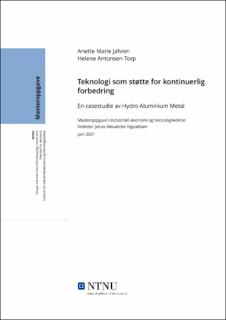| dc.contributor.advisor | Ingvaldsen, Jonas Alexander | |
| dc.contributor.author | Jahren, Anette Marie | |
| dc.contributor.author | Torp, Helene Antonsen | |
| dc.date.accessioned | 2021-10-05T17:21:22Z | |
| dc.date.available | 2021-10-05T17:21:22Z | |
| dc.date.issued | 2021 | |
| dc.identifier | no.ntnu:inspera:85378491:85474058 | |
| dc.identifier.uri | https://hdl.handle.net/11250/2787867 | |
| dc.description.abstract | Organisasjoner i næringslivet er avhengig av utvikling for å holde tritt med konkurransen i egen bransje. En måte å forbedre prosesser i eget arbeid er ved å benytte ny teknologi til å støtte systematisk utvikling. Dette er spesielt formålstjenlig for produksjonsbedrifter i høykostland slik som Norge, som er avhengige av å maksimere utnyttelsen av ressurser for å kunne konkurrere med andre lavkostland. Formålet med denne oppgaven er å bruke en casestudie til å undersøke hvordan en organisasjon i prosessindustrien har lykkes med å implementere og anvende teknologi for å støtte kontinuerlig forbedringsarbeid. I casestudien vil vi se nærmere på introduksjonen og bruken av et internt digitalt forbedringsverktøy i Hydro Aluminium Metall. Gjennom totalt 22 intervjuer med ansatte fra hovedkontoret i Oslo og ved to av Hydros elektrolyseverk i Sunndal og Høyanger innhentet vi erfaringer med implementering av programmet, kalt Team Performance (TP).
Sett i retrospekt var innføringen godt planlagt og ansees som vellykket. Vi ønsket derfor å undersøke hva som gjorde denne innføringen vellykket og om denne prosessen har overføringsverdi for andre bedrifter som ønsker å gjennomføre lignende endringer. På bakgrunn av det fokuserer vi i analysen på valg og hendelser som har vært avgjørende for suksessen, hvilket resulterte i fem suksessfaktorer: (1) gradvis overgang, (2) tillit til system og ledelse, (3) positive forsterkninger, (4) ansvar til operatører og (5) lokal fleksibilitet i et standardiseringsinitiativ. Analysen av disse suksessfaktorene er viktig å dokumentere, ettersom det eksisterende teoretiske grunnlaget om teknologisk støtte av kontinuerlig forbedringsarbeid er mangelfullt. Sammenlignet med teori om suksessfaktorer i kontinuerlig forbedring ser det videre ut til at faktorene tillit og positive forsterkninger har vært særlig viktige for å akseptere den nye teknologien. For praktikere vil innføring av teknologi først og fremst kreve at ledere klarer å plassere den nye teknologien i en meningsfylt kontekst. I tillegg er det sentralt å ha et fundament av tillit mellom ledelse og ansatte for å hindre at den nye teknologien oppleves som en trussel og et overvåkningsverktøy. | |
| dc.description.abstract | Organizations in the business world depend on development to keep up with the competition in their industry. One way of improving internal processes is by exploiting new technology to support systematic improvement. This is especially appropriate for high cost countries like Norway who are dependent on maximizing the utilization of their resources in order to be able to compete with low cost countries. The main purpose of this thesis is therefore to use a case study to study the successful implementation and use of technology to support continuous improvement in an organization in the process industry. In this case study we will have a closer look at the introduction and use of a company specific digital improvement tool in Hydro Aluminium Metal. We have gathered experiences related to the implementation of the program, called Team performance (TP), by conducting a total of 22 interviews with employees from the main oce in Oslo and from two of Hydro’s electrolysis plants in Sunndal and Høyanger.
In hindsight, the introduction can be classified as successful and well planned out. Thus, we wished to study what made this introduction successful, and if this knowledge potentially could be transferred to companies wishing to implement similar changes. With this in mind, our analysis focuses on the actions and events that have been critical in shaping this success. This led us to the following five success factors: (1) gradual change, (2) trust in the system and the managers, (3) positive reinforcements, (4) placing a responsibility on the operators and (5) local flexibility as part of the standardization initiative. It is important to document the analysis of these success factors, as there exists few theoretical contributions on technological support of continuous improvement. Furthermore, by comparing with literature related to success factors in continuous improvement, we find that the factors trust and positive reinforcements have been especially important to make the employees accept the new technology. For practitioners, the introduction of new technology will first and foremost require that managers are able to place the new technology in a meaningful context. Additionally, it will be important to establish a foundation of trust between the leaders and the employees to avoid that the employees perceive the new technology as a threat or as a tool for surveillance. | |
| dc.language | nob | |
| dc.publisher | NTNU | |
| dc.title | Teknologi som støtte for kontinuerlig forbedring - En casestudie av Hydro Aluminium Metal | |
| dc.type | Master thesis | |
